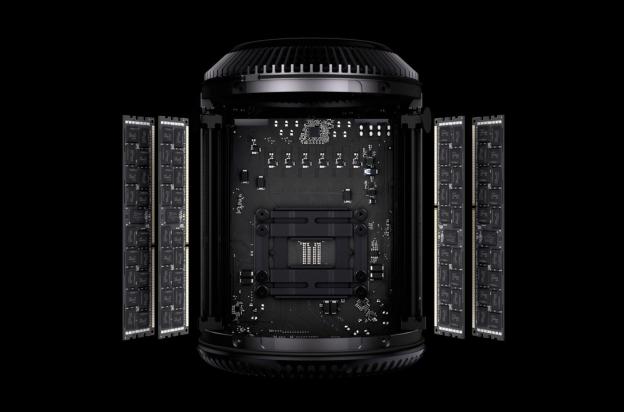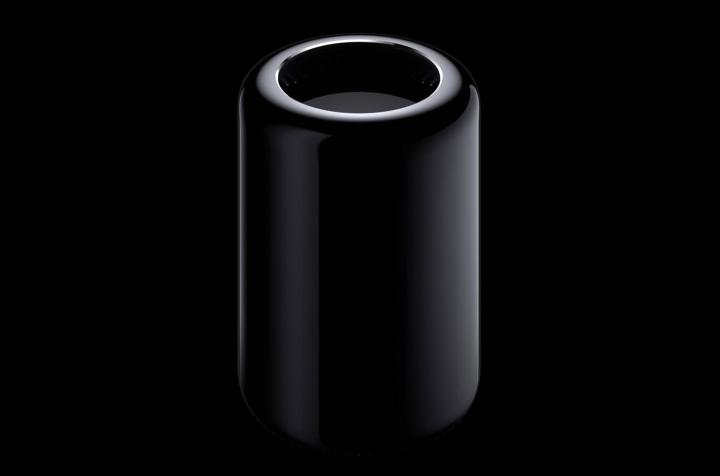
When Apple unveiled its re-imagined Mac Pro at WWDC this month, Apple VP Phil Schiller couldn’t resist muttering “Can’t innovate any more, my ass!” to cheers from the WWDC faithful. And there’s no doubt the new Mac Pro – due to ship sometime later this year at yet-to-be-determined prices – represents a fundamental re-thinking of powerhouse computers. The new Mac Pro will be a sleek (and tiny!) black cylinder, featuring a single top-mounted fan, serious computing horsepower, graphics that can handle three 4K displays (that’s over 24 million pixels!), wicked fast storage, and high-speed connectivity unlike anything else on the market.
Apple’s new Mac Pro will scream. But the Mac Pro isn’t aimed at everyday computer users. It’s aimed at professionals, the people who make movies, craft images the size of billboards, produce albums, create massively complex 3D models, design buildings, and (literally) do rocket science. How is the new Mac Pro going to meet the needs of these very demanding customers?
Expand your horizons
Apple’s Mac Pros have always been fast, and Apple popped snappier processors in the Mac Pros in 2012…but the guts of the system have languished since 2010. Worse, the external design of the current Mac Pros basically dates more than a decade to Apple’s Power Mac G5. Compared to other Macs, the current Mac Pro is a ungainly, hulking behemoth, seemingly forgotten while Apple revised its other desktop systems (the Mac mini and iconic iMac) and notebooks. And they’re expensive: today’s Mac Pros start at $2,500, and options can quickly push them over $10,000.
Understanding the paradigm shift in the new Mac Pro means understanding why the old Mac Pro held on so long: customization, expansion, and upgrades.
Understanding the paradigm shift in the new Mac Pro means understanding why the old Mac Pro held on so long: customization, expansion, and upgrades. These days, neither users nor Apple techs can so much as install extra memory in many of Apple’s mainstream desktops and notebooks (it’d soldered in!). Conversely, the massive Mac Pros have four or eight easily accessible memory slots. They’ve also got two PCI 2.0 ×16 slots that can handle some of the hottest graphics cards on the planet (plus two ×4 slots for less demanding add-ons), making them the only Macs with traditional expansion slots. They also sport four bays for internal storage (SSDs, traditional hard drives, or RAIDs), and an extra optical bay for folks who need something like a Blu-ray burner. They also have a multitude of ports, including FireWire 800 (aka IEEE 1394b), USB 2.0 (not USB 3.0: remember, it’s basically unchanged since 2010), and dual gigabit Ethernet.
These capabilities are overkill for most people – and, indeed, plenty of programmers and gamers run Mac Pros for pure horsepower. But compare that to what’s user-accessible in the new Mac Pro: just the memory and (maybe) the flash-based storage.
Lack of expansion could be a bitter pill for some high-end pros – especially in video editing, where even the current Mac Pro can be limiting. Working with hours of high-definition (or 3D!) footage can require massive storage, along with high-end hardware to transcode, color-correct, splice, catalog, compress, and render video for production.
“Right now we run four edit bays with Mac Pros,” wrote Bin Iwata, a senior tech at a video editing shop in Vancouver, British Columbia. “Right now, there’s just one empty PCI slot between them after accounting for DSP cards, break out boxes, audio interfaces, and shared storage. We’d push that farther if we could.”
Betting on Thunderbolt
Expansion for Apple’s new Mac Pro is all about Thunderbolt, the high-speed connector jointly developed by Apple and Intel that’s now on every other Mac Apple makes. (Sure, there’s USB 3.0, too, but that’s mostly for consumer-level peripherals.) The idea is that Thunderbolt’s performance will let demanding add-ons live outside the Mac Pro. The new Mac Pro will have six Thunderbolt 2 ports (paired on three controllers), each of which can theoretically handle six daisy-chained devices – that’s a total of 36 devices.
“Thunderbolt is great,” said Austin-based audio engineer Michael Houghton. “It’s faster than USB 3, faster than FireWire, brings PCI-grade bandwidth outside the box. I don’t have to crack a case, dig around inside a computer, and worry about damaging frail, frilly-ass, gold-plated connectors to get that performance and reliability. I just pop in a cable.”

Graphics cards and demanding add-ons need high-bandwidth connections to a computer’s memory, CPU, and storage. For years that’s only been available via PCI slots. In theory, each Thunderbolt 2 controller in the new Mac Pros can deliver up to 20 Gbit/s: that’s impressive, and capable of handling real-time 4K video footage and a little extra besides. Thunderbolt 2’s total bandwidth is actually the same as first-generation Thunderbolt, just re-arranged. Thunderbolt 1.0 is split evenly into two channels (one in, one out). Thunderbolt 2 combines them into a single channel. This rearrangement lets Apple punt on the deciding how many (or how few) expansion slots to put in a high-end Mac. The answer is zero: with Thunderbolt 2, users can connect as many (or as few) high-performance peripherals as they like with PCI-like performance.
Of course, there will be some gotchas. As impressive as it is, Thunderbolt 2 isn’t as fast as current PCI technology. A Thunderbolt 2 port offers just a bit more bandwidth than a two-lane PCIe3 slot. In comparison, high-performance graphics cards typically want 16 lanes. That makes Thunderbolt 2 impractical for high-performance graphics expansion, so Mac Pro customers will probably be stuck with whatever graphics cards they buy from Apple. You know … just like every other Mac.
“The new Mac Pro is Apple throwing down a gauntlet with Thunderbolt,” wrote Iwata. “If enough companies pick it up then I think we’re off to the races…”
There are options. Many PCI cards can be used with an expansion chassis: basically, boxes that connect to a Mac via Thunderbolt. (Companies like Sonnet, Magma, and mLogic already make them.) Not all cards currently work with expansion chassis, but hopefully, driver updates can solve some of those problems.
Expansion chassis are a double-edged sword. They can bring PCI hardware to the new Mac Pro, but they add cost and hassle. Who wants a bunch of external boxes and a rats’ nest of Thunderbolt cables to handle storage, PCI slots, and maybe a display or two? On the other hand, expansion chassis can make PCI hardware available to any Mac with a Thunderbolt port. These days, that’s every Mac, down to the diminutive MacBook Airs.
“Last year we started using a couple Thunderbolt PCI expansion chassis with new iMacs and so far they work OK for video acquisition and some audio DSP cards,” wrote Iwata. “We’re seeing more and more support for Thunderbolt from gear makers, and right now we’re working with a producer who brings in his expansion box. When he gets here, he pops it onto our iMacs and when he goes home he pops it into his Retina MacBook. He seems happy.”
What about graphics and FireWire?
Apple’s new Mac Pro will come with two AMD FirePro graphics cards – we don’t know which models, yet. However, it doesn’t look like they’ll be user-replaceable, and only one powers displays. The other is just for high-speed computing via OpenCL: think of it as a co-processor. Apple is making a version of its Final Cut Pro video editor to support the new Mac Pro; similarly, the next versions of Adobe Premiere and After Effects already support OpenCL, as will DaVinci Resolve. In theory, this means the new Mac Pro could do things like edit 4K high-definition video while rendering out video effects in the background. The downside is that folks using other solutions could be paying for an expensive GPU they can’t use. That includes users of Avid systems (which rely on the CPU or its own PCI boards) and software built for Nvidia’s competing CUDA technology.

The new Mac Pro also lacks FireWire. Consumers never strongly embraced FireWire/IEEE 1394, but some high-end cameras and scientific gizmos rely on it. FireWire can carry up to 45 watts at anywhere from 8 to 32 volts: that’s more power than any other digital interface. Folks who don’t need it can use inexpensive Thunderbolt-to-FireWire converters for their gear, but others may be out of luck, including professional photographers who use medium format camera backs from the likes of Leaf/Phase One, Hasselblad, and others.
What’s old is new again?
In a way, Apple’s forthcoming Mac Pro isn’t so much about specs as Apple’s core principles. Apple’s earliest Macs didn’t have internal expansion; neither did the iMac, and Apple has pushed add-ons outside its products for most of the last decade. The ten-year-old design of the current Mac Pro is the last hurrah of user-upgradable Macs.
In a way, Apple’s forthcoming Mac Pro isn’t so much about specs as Apple’s core principles.
“The new Mac Pro is Apple throwing down a gauntlet with Thunderbolt,” wrote Iwata. “If enough companies pick it up then I think we’re off to the races, especially if they support the Mac Pro’s extra GPU. To me, Thunderbolt is gaining traction, but we won’t know for another year or two.”
Despite the high cost of the current Mac Pro (the new Mac Pro will probably be just as pricey), at a certain point a computer is a peripheral for the expensive gear creative professionals use–one piece of a larger puzzle.
“Our studios have about a hundred grand in hardware that depends on PCI slots, so I sure won’t be first in line for the new Mac Pro,” laughed Houghton. “But everyone complained when Apple moved to FireWire, then to OS X, then to Intel chips. Some people switched horses each time, but the new Mac Pros don’t strike me as disruptive as some other changes have been.”







